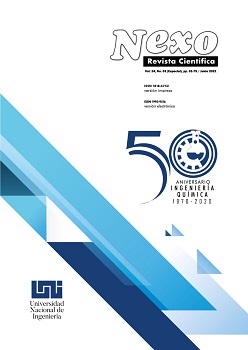Estudio piloto para la deposición de circona mediante plasma CVD
DOI:
https://doi.org/10.5377/nexo.v34i03.11857Palabras clave:
Acetilacetonato de circonio, Recubrimientos de circona, PECVDResumen
Este trabajo informa sobre pruebas preliminares llevadas a cabo para la deposición de recubrimientos de circona sobre sustratos de acero inoxidable mediante la técnica de Deposición Química de Vapor asistida por Plasma (PECVD). La deposición de circona mediante esta técnica permite el control de variables tales como temperatura de deposición, potencia del plasma, presión de operación, cantidad de precursor disponible para la formación de especies precursoras en fase gaseosa, flujo volumétrico de gas de arrastre y de gas oxidante y temperatura de evaporación del precursor. Una variable que no opere en su punto óptimo es suficiente para no obtener depósitos de circona, u obtener depósitos heterogéneos sobre la superficie del sustrato. Preliminarmente se realizaron deposiciones a 500 y 900 °C, variando la potencia del plasma entre 100-250 W y la temperatura de evaporación del precursor a 80 y 120 °C. Se obtuvieron películas homogéneas a 500 °C/250 W/120 °C de evaporación. Sin embargo, el incremento en la temperatura de evaporación del precursor de 80-120 ºC a 200 °C mejoró la eficiencia en la deposición. También se determinó que la posición óptima del sustrato está en el centro de la zona de calentamiento del horno, y que la temperatura de deposición y el % de oxígeno en el plasma influye directamente en la morfología y estructura cristalina obtenida. Estos resultados preliminares constituyeron el punto de partida para evaluar la influencia de otras variables sobre la composición química, estructura cristalina, morfología y grosor de recubrimientos de circona estabilizada con itria (YSZ).
Descargas
510
Descargas
Publicado
Cómo citar
Número
Sección
Licencia
Derechos de autor 2021 Universidad Nacional de Ingeniería

Esta obra está bajo una licencia internacional Creative Commons Atribución 4.0.
Los autores que publican en Nexo Revista Científica están de acuerdo con los siguientes términos:
- Los autores conservan los derechos de autor y conceden a la revista el derecho de la primera publicación bajo la licencia Creative Commons Attribution License, que permite a otros compartir el trabajo con un reconocimiento a la autoría de la obra y a la publicación inicial en Nexo Revista Científica.
- Los autores pueden establecer por separado acuerdos adicionales para la distribución no exclusiva de la versión de la obra publicada en la revista (por ejemplo, en un repositorio institucional o en un libro) con el reconocimiento de su publicación inicial en Nexo Revista Científica.
- Se permite y se anima a los autores a difundir sus trabajos electrónicamente (por ejemplo, en repositorios institucionales o en su propio sitio web) antes y durante el proceso de envío, ya que puede dar lugar a intercambios productivos, así como a una citación más temprana y mayor de los trabajos publicados.










